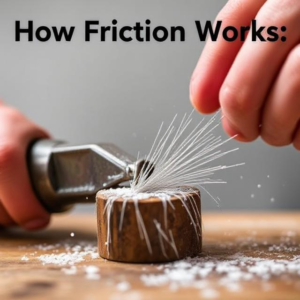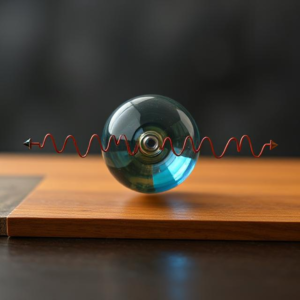Friction and Its Types Explained Simply
Friction is a force that resists motion between two surfaces that are in contact with each other. When you push an object, friction is the force that tries to stop it from moving. It’s everywhere—whether you’re walking, sliding a book across a table, or driving a car.

Let’s break down friction and its types in a simple and easy-to-understand way.
1. What is Friction?
Imagine you’re pushing a box across the floor. The box doesn’t slide easily, right? It resists your push, and that’s because of friction.
Friction is a force that works against movement. It happens whenever two objects are in contact and one tries to slide or move over the other. The rougher the surfaces, the more friction there will be.
Think about rubbing your hands together. You feel warmth because of friction between your hands. When objects move over each other, friction turns some of the energy into heat.
2. Why Does Friction Happen?
Friction occurs because surfaces are never perfectly smooth. Even if an object looks smooth, when you look very closely, you’ll see tiny bumps and grooves. These little imperfections cause the surfaces to rub against each other when they move, creating resistance.
There are two main factors that affect the amount of friction:
- The roughness of the surfaces: Rougher surfaces create more friction because the bumps and grooves stick together more.
- The weight or force pushing the objects together: The harder two surfaces are pushed together, the more friction there will be.
3. Types of Friction
Friction can be divided into four main types, each with different characteristics:
a. Static Friction (The “Sticking” Friction)
- What it is: Static friction is the friction that keeps an object at rest. It prevents an object from moving when a force is applied to it.
- Example: Imagine trying to push a heavy box across the floor. At first, the box doesn’t move because static friction is resisting your push. Once you apply enough force to overcome static friction, the box will start to move.
- Key Point: Static friction is usually stronger than other types of friction because it has to overcome the initial resistance to motion.
b. Kinetic (Sliding) Friction (The “Sliding” Friction)
- What it is: Kinetic friction is the friction that acts when two surfaces are sliding past each other. Once an object starts moving, static friction is replaced by kinetic friction.
- Example: Once the box starts moving across the floor, it experiences kinetic friction. This type of friction resists the sliding motion of the object.
- Key Point: Kinetic friction is usually weaker than static friction, meaning it takes less force to keep an object moving once it has started.
c. Rolling Friction (When Objects Roll)
- What it is: Rolling friction occurs when an object with a round shape (like a wheel or a ball) rolls over a surface. This type of friction is much weaker than both static and kinetic friction.
- Example: A car’s wheels rolling on the road experience rolling friction. The wheels roll instead of slide, so there’s less resistance compared to sliding the car without wheels.
- Key Point: Rolling friction is very small, which is why we use wheels and bearings to make objects move more easily.
d. Fluid Friction (When Objects Move Through Fluids)
- What it is: Fluid friction happens when an object moves through a fluid (which can be a liquid or a gas). This type of friction depends on how fast the object is moving and the viscosity (thickness) of the fluid.
- Example: When you swim, you feel resistance from the water. This is fluid friction. Similarly, when a car drives through the air, air resistance (a type of fluid friction) slows it down.
- Key Point: Fluid friction increases as the speed of the object increases and as the viscosity of the fluid increases.
4. How Do We Reduce Friction?
In many cases, we want to reduce friction to make movement easier. Here are a few ways to do that:
- Lubricants: Adding lubricants (like oil or grease) between surfaces reduces friction by creating a thin layer that makes it easier for the surfaces to slide over each other.
- Smooth Surfaces: Polishing or smoothing surfaces (like in the case of ball bearings) helps reduce friction because smooth surfaces have fewer bumps and grooves.
- Wheels and Rollers: Using wheels or rollers (like on a car or a shopping cart) reduces friction because rolling friction is weaker than sliding friction.
- Streamlining: To reduce fluid friction, objects (like airplanes or boats) are often shaped in a streamlined way, making it easier for air or water to flow smoothly around them.
5. How Do We Increase Friction?
In some cases, we want to increase friction to prevent slipping or sliding. Here’s how to do that:
- Rougher Surfaces: Rougher surfaces create more friction. For example, sandpaper is rough to help smooth other materials, and shoes have textured soles to increase grip.
- Adding Materials: Adding materials like sand or salt to icy roads increases friction, helping cars grip the road better.
- More Weight: Increasing the weight or force pressing the surfaces together will usually increase friction. This is why car tires are designed to press more firmly against the road.
6. Summary of Types of Friction
- Static Friction: Resists the start of motion (strongest friction).
- Kinetic (Sliding) Friction: Resists motion once an object is moving.
- Rolling Friction: Occurs when round objects roll over surfaces (weakest friction).
- Fluid Friction: Occurs when an object moves through a liquid or gas (like water or air).
7. Why is Friction Important?
Friction is important in many aspects of everyday life. For example:
- Walking: Without friction, we wouldn’t be able to walk because our feet would slip on the ground.
- Brakes: Friction is used in brakes to slow down or stop vehicles (like cars, bikes, or roller coasters).
- Writing: Friction between a pencil and paper allows you to write.
friction is a force that resists movement, and there are different types, including static, kinetic, rolling, and fluid friction. Understanding friction helps us make the most of it in our daily lives—whether we want to reduce it (for smoother movement) or increase it (for better grip or control).











